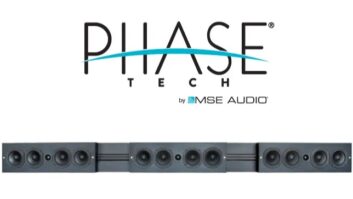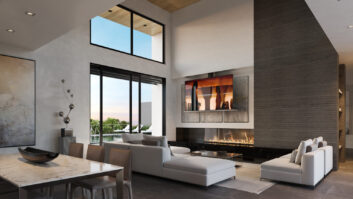In one of its broadest product launches in decades, Polk is unveiling at least 21 new home speaker models that include the company’s first DSP-equipped freestanding subwoofers and its first custom-install speakers designed specifically for center-channel and surround-sound applications.
The DSP-equipped subwoofers appear in two series, the top-end MicroPRO and high-value DSW PRO series. The custom-installed speakers dedicated to center-channel and surround use appear in the LCi series.
The company is also revamping its RTi series of freestanding left-right speakers, which occupy the better position in the company’s good-better-best selection of three freestanding-speaker series.
It’s also expanding its selection of THX Ultra2-certified custom speakers in the RT group.
Additionally, it is redesigning the freestanding center-channel speakers and freestanding surround speakers intended to sonically match the RTi series of left-right speakers.
The MicroPRO subwoofers are all compact, grille-less models comprising the MicroPRO series, promoted as Polk’s best-ever powered subs at prices of $950, $1,180, $1,450 and $1,780. They ship in June.
All MicroPRO models use DSP to:
- Perform crossover, volume and phase functions in the digital domain.
- Reduce distortion by active means through a proprietary “zero-latency system that maximizes dynamic output” and doesn’t rely on what Polk called “slow-responding feedback [servo] techniques;” servo-feedback techniques optimize the ability of a woofer to reproduce steady-state signals, Polk claimed, but do little to enhance the quality of transient response.
- Perform boundary-compensation functions to allow for flexible placement options without affecting sonic performance. The subs use digital EQ to compensate for response changes when a subwoofer is placed in a corner, mid-room, along a long wall or along a short wall.
Until now, the company hadn’t offered boundary compensation in any subwoofer, freestanding or custom-installed, in analog or digital form, but freestanding and custom installed full-range speakers have offered boundary compensation.
All MicroPRO models except for the opening-price model also incorporate automatic room-error correction. Polk said it used a proprietary method of automatic digital room correction to preserve dynamics and transient response, “optimizing the in-room time response of the system rather than simply equalizing the steady-state response.” The company declined to elaborate until it completes a patent application.
All four MicroPROs feature 1,200-watt continuous digital amp and bottom-mounted, square-shaped passive bass radiators to use as much surface area as possible to augment output. They join six other new powered subwoofers in Polk’s largest-ever subwoofer introduction.
Three new replacement subs in the DSW PRO series offer the same DSP features as the MicroPRO models except for automatic room correction. The PRO models ship in June at prices from $480 to $700. They feature active downward-firing drivers from 8 inches to 12 inches in diameter and digital amps rated from 180 watts to 250 watts.
In custom-install speakers, Polk announced the first dedicated center- and surround-channel models for the LCi Series, the top of a three-tier series of custom speakers.
The LCi-C center and LC65FX and LC80FX bipole/dipole surrounds due in the spring will join four LCi in-wall and in-ceiling speakers.
The LCi-C is a rectangular in-wall speaker with horizontal mounting, thanks to dual 5.25-inch cone drivers flanking a 1-inch tweeter. The woofers are in a cascade tapered array, with one driver playing only bass frequencies and the other playing bass and midrange to deliver broad, even sound coverage for off-axis listeners. The array avoids the lobing effects that Polk said plague other horizontal-oriented, multi-driver center speakers.
The LC65FX is a rectangular in-wall surround speaker that uses two 0.75-inch ring radiator tweeters along and a 6.5-inch cone woofer. The LC80FX is a round in-ceiling speaker featuring one 8-inch mid/bass driver and two 0.75-inch tweeters. The radiation patterns of both are selectable between bipole and dipole modes through a front baffle-mounted switch.
All LCi speakers feature response-compensation switches to optimize speaker response when they are placed in less -than-ideal locations.
THX custom speakers: The LCi series includes the RTS group of THX Ultra2-certified speakers for home theater use. Here the company is expanding the RTS group with a center channel and surround speaker. The RTS-C and RTS-FX models are due in the spring to join the RTS105 in-wall and RTS100 in-ceiling model, the only in-ceiling speaker available in 2006 with THX Ultra2 certification.
The RTS-C is a rectangular, horizontal in-wall loudspeaker with two 5.25-inch woofers in a cascade tapered array flanking a 1-inch ring-radiator tweeter. A rigid MDF enclosure is supplied to ensure consistent driver loading and thus predictable high performance.
The RTS-FX is a rectangular in-wall surround using dual 3.5-inch midrange drivers, two 0.75-inch ring-radiator tweeters, one 6.5-inch woofer and integrated enclosure.
The RTS-FX radiation pattern is selectable between bipole “solid” and dipole “diffuse” modes via a front baffle-mounted switch. In the THX-default solid mode, all drivers and tweeters are in-phase to produce solid, discrete surround imaging.
The RTS-C and RTS-FX also feature response-control switches.
RTi freestanding speakers: The company revamped its RTi Series, which occupies the better position in the company’s good-better-best selection of Monitor, RTi and LSi series. The five-SKU RTi series of left-right speakers now features all-new drivers, new tapered enclosure, and in the floor-standing models, an enhanced venting technology called Power Port Plus.
Three floorstanding and two bookshelf models are due in June in cherry or black oak real-wood veneer finishes. All are magnetically shielded and feature tapered enclosure to break up inside standing-wave resonances to produce clearer, more accurate midrange response.
The tapered enclosure, computer-designed tweeter faceplate radius, standoff grilles and baffle-edge radii minimize diffraction to create more open and spacious imaging.
All models feature Polk’s Power Port technology to reduce turbulence at the port’s mouth, reducing “chuffing” or “port noise” and providing deeper, more powerful, lower distortion bass than could be achieved with conventional ported or sealed designs of comparable size.
The floor-standing A5, A7 and A9 feature Power Port Plus, which uses two ports (one front, one rear) and internal “plates” to further reduce air turbulence and increase bass efficiency.
RTi-matched centers, surrounds: In another complete redesign, Polk revamped its CSi series center-channel speakers and FXi surround speakers, all freestanding models tuned to match Polk’s new RTi Series of floorstanding and bookshelf loudspeakers. They’re due in May with all-new drivers and new cosmetics.













